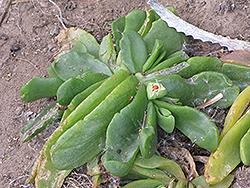It's all about ...
plants

Tongue Leaf Plant
Glottiphyllum linguiforme
Height: 4 inches
Spread: 12 inches
Sunlight:
![]()
![]()
Hardiness Zone: 8a
Description:
This well-named variety produces small branching stems, that form a mat of tongue shaped leaves; bright yellow, daisy-like flowers in fall; avoid overwatering, and keep dry from mid-fall until mid-spring; great for containers and rock gardens
Ornamental Features
Tongue Leaf Plant features showy yellow daisy flowers along the stems from mid to late fall. Its attractive succulent oval leaves remain green in colour throughout the year.
Landscape Attributes
Tongue Leaf Plant is an herbaceous evergreen perennial with a ground-hugging habit of growth. Its medium texture blends into the garden, but can always be balanced by a couple of finer or coarser plants for an effective composition.
This is a relatively low maintenance plant, and is best cleaned up in early spring before it resumes active growth for the season. It has no significant negative characteristics.
Tongue Leaf Plant is recommended for the following landscape applications;
- Rock/Alpine Gardens
- General Garden Use
- Groundcover
- Container Planting
Planting & Growing
Tongue Leaf Plant will grow to be only 4 inches tall at maturity, with a spread of 12 inches. Its foliage tends to remain low and dense right to the ground. It grows at a slow rate, and under ideal conditions can be expected to live for approximately 20 years. As an evegreen perennial, this plant will typically keep its form and foliage year-round.
This plant does best in full sun to partial shade. It prefers dry to average moisture levels with very well-drained soil, and will often die in standing water. It is considered to be drought-tolerant, and thus makes an ideal choice for a low-water garden or xeriscape application. It is not particular as to soil pH, but grows best in poor soils. It is somewhat tolerant of urban pollution. This species is not originally from North America. It can be propagated by division.
Tongue Leaf Plant is a fine choice for the garden, but it is also a good selection for planting in outdoor pots and containers. Because of its spreading habit of growth, it is ideally suited for use as a 'spiller' in the 'spiller-thriller-filler' container combination; plant it near the edges where it can spill gracefully over the pot. Note that when growing plants in outdoor containers and baskets, they may require more frequent waterings than they would in the yard or garden. Be aware that in our climate, most plants cannot be expected to survive the winter if left in containers outdoors, and this plant is no exception. Contact our experts for more information on how to protect it over the winter months.
This plant is not reliably hardy in our region, and certain restrictions may apply; contact the store for more information.
